





The following discussion covers 7 species of uniquely blue fan palms that are excellent landscape trees for low desert areas where frost is not a severe problem, but excessive heat can be a common occurence (eg. southern California, western Mexico, the Mediterranean, South Africa, Australian deserts etc.).
Blue palms seem particularly adapted to desert situations as the dusting of white powder that gives the leaves their blue coloration has some protective effects by reducing transpiration in hot dry weather. In addition, the blue color can be a wonderful contrast with surrounding landscape plants of different colors, making these palms striking and ornamental specimen trees and often sought after by landscapers, both professional and amateur. This article addresses only fan palms (palmate leaves) but there are a few feather (aka pinnate-leaved palms) that also have some blue color and are excellent desert plants as well. Those may be discussed in another article.
Brahea armata (Mexican Blue Fan Palm)- this is probably the quintessential desert palm as it is attractive, highly available and perfectly suited to desert climates. There are many other species of Brahea, including another blue one (Brahea decumbens) that also perform excellently in desert situations, but they can be discussed in a different article. Brahea decumbens is a wonderful palm, but nearly impossible to attain for the average grower, and way too slow to be considered a significant landscape palm. Brahea armatas are considered moderate growers in terms of growing speed, but this term is relative to the growth of other palms, not other trees. So one must be prepared for what may seem like exceptionally slow growing trees when cultivating palms. This species grows pretty well in just about any soil type, from sandy loam to heavy clay. If grown in the latter, however, overwatering could be a problem, so once this palm is established it is best to water it occasionally when hot (1-2x a week), and rarely, if at all during cooler months. Once planted, this species is particularly unhappy about being moved, so careful consideration should be paid to eventual size, width and location. Moving large Braheas usually ends up in one owning a dead palm. This species is one of the more cold harder palms in cultivation, tolerating temps into the mid teens with few problems. It is, however, very difficult to grow this palm in a humid tropical climate (such as in the southeast US or northeast Australia). Though an excellent xeriscape palm, these also can grow happily in more 'tropical ' desert landscapes and can make an incredibly striking statement when their pale blue leaves are surrounded by more lush green foliage. Brahea armatas eventually grow up to about 35' in about 25-30 years. They have uniquely long, arching pale yellow flowers that extend far beyond the leaf crown in the fall. it is a not always a self-cleaning palm, meaning it can develop a 'petticoat' of dead leaves that hang down around the otherwise bare trunk. Most growers remove these dead leaves periodically to not only improve the look of the palm, but also to keep the palm from being infested with rats, pigeons, squirrels or owls that like to live in these petticoats. Care must be taken when pruning this species as it has sharp, hooked yellow teeth along the petioles (the stem-like structure that supports the palmate part of the leaf). Brahea armata is a commonly available species, and most garden outlet centers sell this palm. Larger ones are readily availalbe, at least in the southern US, at nurseries specializing in landscape palms. It is not one of the cheapest palms, but not one the most expensive, either.
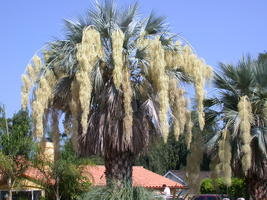
pair of palms flowering in southern California
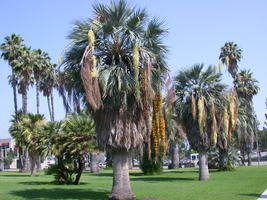
another pair of palms flowering and with fruit, fall, southern California
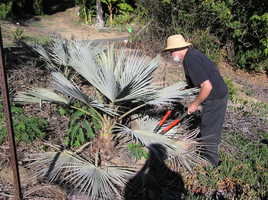
pruning a younger palm
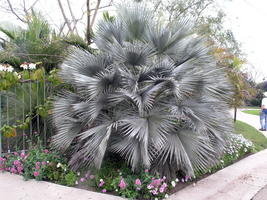
exceptional palm growing in desert climate, southern California
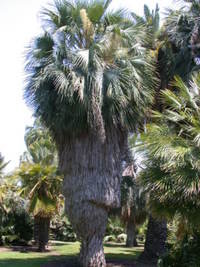
mature palm with a petticoat
Bismarckia nobilis (Bismarck Palm)- this Madagascan native is similarly blue to Brahea armata, but a much more massive and elegant fan palm. There are two forms of Bismarckia- blue and green. These two varieties are so different in terms of climate tolerance that they should almost be treated as different species. The green form is NOT a great palm for deserts, particularly if there is any danger of frost. However even the blue form is not quite as cold hardy a palm as Brahea armata is, particularly when young, so its use is a bit more limited to the warmer desert areas of the world. Unlike Brahea armata, this palm is excellently suited for humid tropical climates and in fact grows better in those than in the dry desert situations. Still, it does exceedling well as a desert palm so is included in this discussion. Bismarckias are a bit pickier in terms of soil type and resent being planted in very heavy clays, though most will tolerate them as long as they are not watered too heavily in cold weather. Like Braheas, this palm is highly intolerant of being moved once established so be sure to plant it where it will stay forever. Still, it is a relatively easy and carefree palm and one of the most impressive palms one can grow in a desert climate. Bismarckias are self cleaning palms to some degree, but most growers trim the dead hanging leaves as they are unsightly, even if they do fall off in a year or two. At least these have no sharp teeth along the petioles. Though once rare palms, Bismarckias are becoming so popular that even most garden outlet centers now carry them routinely at quite reasonable prices. Be sure, however, that you are getting a Blue Bismarckia. Even if getting a small seedling, these can usually be distinguished from the green ones by their immature leaf color (deep purple or maroon, as opposed to dull green).
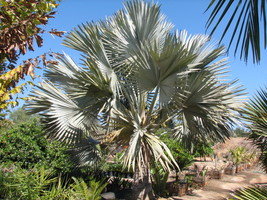
female palm in seed (this species is diocecious- palms are either male or female) in southern California
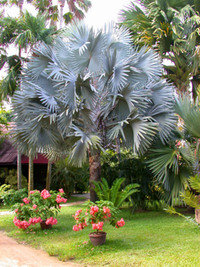
exceptionally blue palm growing in a tropical climate (Thailand)
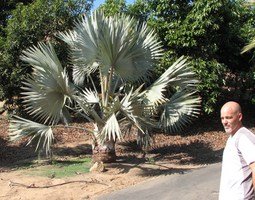
a trunking palm in an inland landscape, southern California
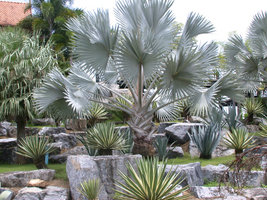
this is an exceptionally pale blue-leaved plant in another desert landscape setting
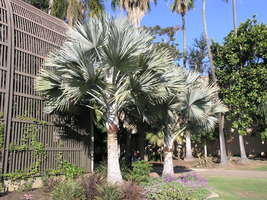
Some of the larger palms in southern California
Chamaerops humilis var. argentea (aka cerifera) (Blue Mediterranean Fan Palm)- this is another ideal palm for desert climates- even the colder ones, as it is hardy perhaps below 10F. Like the more common green form, which is one of the most commonly used landscape palms throughout the world, it is a suckering palm, meaning it has many stems, not just a single trunk. This form of Chamaerops is much more slow growing than the regular form, which many consider slow growing to begin with. However it is an extremely ornamental plant, and probably one of the bluest palms there are. Chamaerops will grow in just about any soil type there is, from sand to clay, though this plant actually appears to prefer the latter for some reason. What this particular form does not tolerate is overhead watering. Tap water on the crown of the blue Chamaerops will often lead to bud or crown rot (the growing center of the palm, where all the leaves come out) and death of that trunk (good thing it's a suckering palm). So watering this plant is best done by soakers, low emitters or drip systems. For some reason rain water does not appear to be as much of an issue. However, similar to Brahea armata, this form of Chamaerops is less suited to warm, humid climates than its green counterpart and cold, wet winters of the southeast will ofte result in crown rot. This palm will grow to maybe 20' tall (and nearly as wide) in 30 years or more, but it hasn't been around in cultivation long enough to know for sure. It is certainly a much slower grower than its more common green cousin.
Since it is a suckering palm, new suckers are produced all the time necessitating constant pruning in order to keep this plant from forming a massive, spiny thicket. Trimming this palm requires extreme caution at is one of the sharpest and most fiercly armed palm trees. Reaching in to the center of the palm to trim those leaves can be a dangerous challenge, so it is best to keep on top of this one and prune often. Chamaerops are one of the easier palms to move even as large plants, and larger plants can safely be moved with a back hoe with little risk of loss of the palm. Ths does not necessarily hold true with the blue form of this species, however, and as more massive plants have finally begun to exist in cultivation, we are finding these can be nearly as hard to move successfully as are Brahea armatas.... so plant these where you want them to stay forever! Be sure when you purchase a 'cerifera' Chamaerops it is already showing blue leaves. Seeds from blue palms often produce normal green plants, so it is not recommended to invest a lot in 'cerifera' seeds. Until recently this was considered an extremely rare form, but now, due to its popularity, it is becoming much more available, and 1-5 gal pots are readily available in some nurseries, even those not specializing in palms, for a reasonable cost. It may be that the seedlings seen in nurseries now are primarily divisions from larger plants, not seed grown individuals.
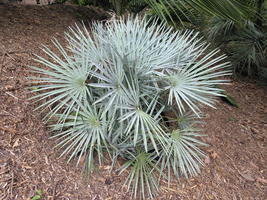
Though still a seedling, there are precious few larger palms than this currently in southern California
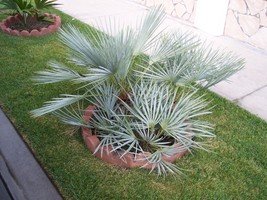
here is another nice seedling growing in southern California
Serenoa repens 'blue' (Blue Saw Palmetto)- Serenoa repens is a Florida native that is normally a bright green to pale green palm, but many populations along the eastern coast are notably 'bluer'. This color variation is much sought after as it is unusual and much more ornamental than the normal green form. In its native Florida, this palm is a moderate grower, though slow compared to many other palms in that subtropical climate. However, in a dry, desert climate this is a much slower growing palm, still, easily the slowest of all the blue palms discussed in this article. It is so slow, in fact, that realistically it is not a good choice for landscaping unless one has extreme patience or really likes to plan ahead. But since it is readily available through mail order, one can sometimes obtain relatively large ones (5 gal) to get a head start. Once it starts to form a trunk its growth rate increases markedly. The problem with buying one sight unseen is there is no way to ensure getting a truly blue form. Seed from blue plants often produces green plants, and since the blue color is only apparent as the palm matures, young plants cannot, for certain, be categorized as blue or normal green. This is a low growing (6' is pretty much as tall as it gets in desert climates), suckering palm, well known for its 'saw-like' petioles (hence the name) which can be hazardous to climb through or prune. However, when compared to Chamaerops, this is a relatively tame palm from a danger standpoint. It is also an extremely cold tolerant palm, able to tolerate temps below the teens. Though it seems to prefer sandy soils, it is a very adaptable palm and easily the most salt tolerant of all the blue fan palms, seemingly unaffected by very high levels of salt in nearby ponds.
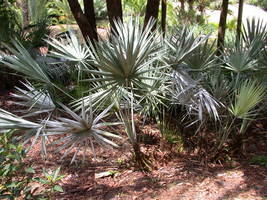
This is a younger blue Serenoa repens growing in Florida, where it is a much faster growing palm than in a desert climate
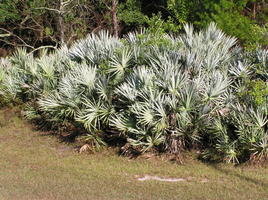
Though also in Florida, this paler, bluer version of Serenoa repens grows well in desert climates as well
Nannorrhops ritchiana (Mazuri Palm)- this is a native of the Middle East and is one of the few palms that can survive the brutal environmental conditions that exist there. With all climatic conditions considered, this is a candidate for the world's hardiest palm. It tolerates extreme frosts down into the low teens, if not lower, but it is also extremely drought, wind and heat tolerant. In some parts of its native range, in areas like Iran and Iraq, it is the only plant of any size that can survive. This is a suckering palm also, and mature trees actually become true branching palms- one of the few branching palms in existence. This palm comes in several shades of green to blue-green, with true pale blue plants being fairly rare. Unfortunatelly it can be difficult to tell at the seedling stage how blue this plant will get, so when seeking a blue Nannorrhops, be sure to get them from a reputable nursery. As it matures it will develop an interesting yellow-orange fuzz around the upper trunks, the consistency of sheep wool. The petioles are barely armed, so trimming this species is not a risky adventure. This is the only blue monocarpic palm- after a stem flowers, it dies and has to be removed. This flowering does not affect the rest of the plant, fortunately. Young seedlings are a bit touchy and prone to rot, so it is best to start out with a large 1 gal-5 gal (or larger) if planting directly outdoors. Soil type is somewhat important with this species as it does not often do well in heavy clays, much preferring very sandy or well draining soils. It is, however, a moderately salt tolerant palm and will grow well if planted somewhat near inland seas or lakes with some salinity. It eventually grows to about 15' tall in 20 years or more.
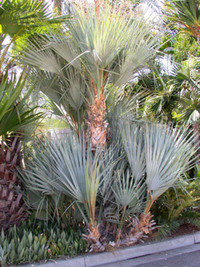
a well trimmed palm in southern California
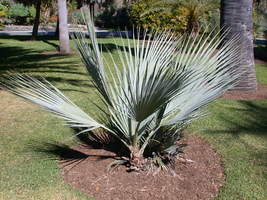
this individual, growing in southern California, is an example of one of the bluest forms of this species
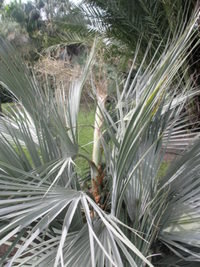
this is the same palm years later, showing on stem flowering
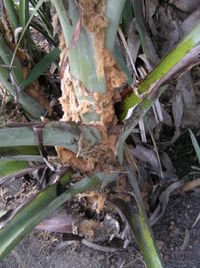
close up showing the heavy wool typically seen in older palms
Hyphaene coriacea (Doum Palm)- this is an African species, one of several Hyphaene, all which have bluish-green leaves (some more than others). But this is by far the most commonly grown in cultivation and most readily available. It is a native to very dry, desert areas with almost no appreciable rainfal most of the year. It gets most of its water from very deep roots. Like Nannorrhops, most Hyphaene are true branching palms, though this species branches right at or above ground level, so it just looks like a suckering palm. Some Hyphaene are the most impressive branching palms of all the branching palms, sometimes branching dichotomously 20x or more. This is the least hardy of the blue fan palms to be discussed in this article, only barely tolerating temperatures below 27F for a short time. Freezes below that will usualy defoliate the palm, but it does have an amazing ability to grow back from the 'dead' after such an occurence, as long as the freeze was not too extreme. Hyphaene are far better adapted to tropical climates where it never gets cold, and are relatively fast growers in such climates. However they still are excellent dry desert palms and are one of the most unusual and ornamental of the bluish fan palms and there are a number of mature palms growing in deserts as landscape palms throughout the world. Most seedlings begin to branch, or split, at about 5-7 years when they are large 5 gal to 15 gal sized palms (3'+) and eventually grow into 2-5 strongly arching trunks each topped with a head of very large, costapalmate leaves. Costapalmate leaves are very curved palmate leaves with a midrib down the middle (as apposed to strictly palmate leaves which are fairly flat). These are still considered fan palms, but a costapalmate leaf is sort of a mixture of palmate leaf with pinnate leaf. See the photo below of the Sabal uresana leaf (also a costapalmate species). The petioles of this species are particularly ornamental, with large, jet-black hooked teeth and bright orange-yellows fading to pale blue-green. This palm prefers a very well draining soil and may rot or suffer in heavy clays.
Note: there are several other species of Hyphaene and some are growing well in southern California (Hyphaene thebaica, dichotoma and petersiana). The growing conditions and above comments pretty much pertain to these palms as well, with a few exceptions. Hyphaene petersiana, a much rarer palm in cultivation, seems to be a relatively resistant brancher and most of these end up being solitary palms. However, on the good side, this last species seems to be more startlingly blue than any of the other species and my guess is it will quickly catch up in popularity with Hyphaene coriacea as THE Hyphaene to grow in desert regions.
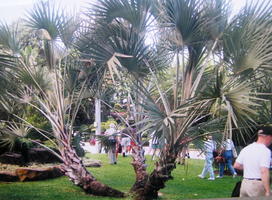
excellent specimen growing in a tropical climate (Thailand)
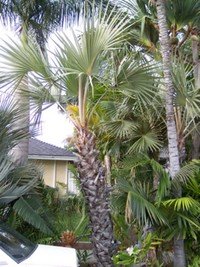
older California palm in a crowded palm garden
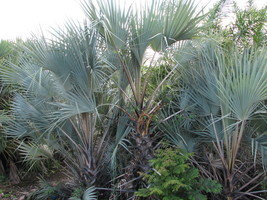
larger palms showing more blue than most
Sabal uresana (Savannah Palmetto)- this is one of many species of Sabal, all American natives, and most are excellently adapted to desert life. However this is the only species that makes bluish leaves (some are more blue than others). This is one of the taller blue palms, growing up to 35', but taking many decades, to get there. Seedlings can be amazingly slow growing, taking 10-20 years sometimes just to form a trunk (Sabals grow faster in tropical climates, but very slow in desert ones, particularly this species). But it is during the advanced seedling stage when this palm looks the most ornamental. Trunking, tall palms can be a bit tattered looking and the leaves don't seem to retain as much blue as in the seedlings. This palm needs to be trimmed regularly or they will develop a large, messy petticoat. The woven trunk of retained leaf bases is one of the more ornamental trunks (see photo below). Though Sabals have no teeth along their petioles, the edges can still be razor sharp, so caution when holding on to these when pruning. This is another one of those palms that is not easy to move once established. It is a fairly cold hardy species, tolerating frosts down to the mid 20s, or perhaps a bit lower.
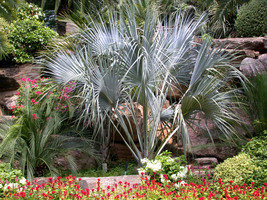
one of the bluest individuals I have seen- a large seedling in Thailand
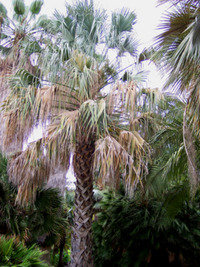
mature palm in southern California showing a bit more green in the leaf color than when it was a seedling
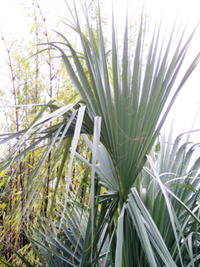
close of up the leaf showing the costapalmate shape
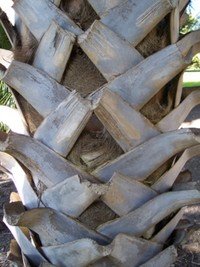
Trunk of Sabal uresana close up
Are there other blue fan palms that can grow in the desert areas? Sure, but they are either to rare/slow to discuss here (eg. Brahea decumbens)
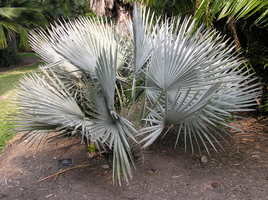
Brahea decumbens in southern California- very old and well known specimen in the Huntington Gardens- probably 30 years old or more
or just too cold sensitive to survive in only the very best protected desert climates.
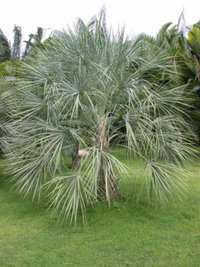
This is Livistona loryphylla, a blue-green fan palm that is very rare in cultivation and one of the most cold sensitive of the Australian Livistonas
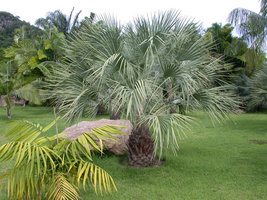
Livistona victoriae is a pretty decent blue-green fam palm that closely resembles Brahea armata, only it takes 10x longer to attain any size and is very cold sensitive
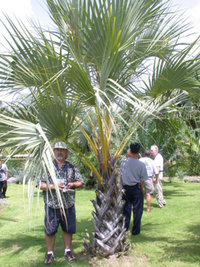
Medemia argun, a close relative of Hyphaenes and Bismarckias is a very touchy and difficult palm to grow, but excellently adapted to a desert cliamte and sandy soil. However, it is relatively cold sensitive so needs to be grown in a mostly frost free climate.
There are other blue fan palms in cultivation -Latanias are very grey to almost blue and look a like Bismarckias, and Mauritiellas are fantastically blue palms. However, for the most part, these palms are stricly tropical and do not do very well in our deserts here in California (some Latanias will survive here, but struggle mightly often).
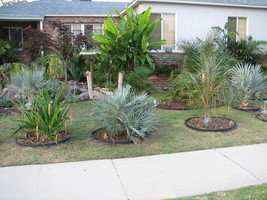
Author's front yard (relatively new yard) showing 3 of his blue palm seedlings: Brahea armata on left, Chamaerops humilis 'cerifera' in the middle, and a Bismarckia on the right
Cold Hardy Palm Trees For Landscape Design And Planting In The United States
Why Sabal Palm is The Best Choice You Should Opt For?
Introduction to the Chamaedorea Palms- excellent genus for both out and indoor use
The Right Touch: 13 Soft, Fuzzy Plants for Gardens and Pots
The Weepers and the Creepers: 10 Intriguing Trees for Your Garden
Celebrate a Sunny Climate With the Right Leafy Palm for Your Site
Copyright © www.100flowers.win Botanic Garden All Rights Reserved